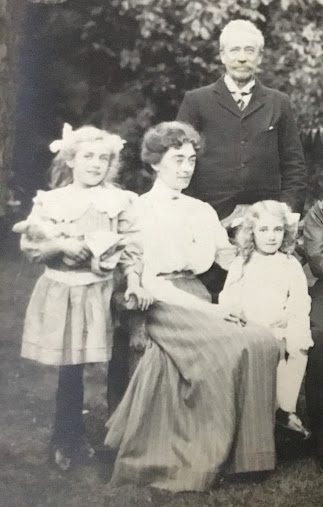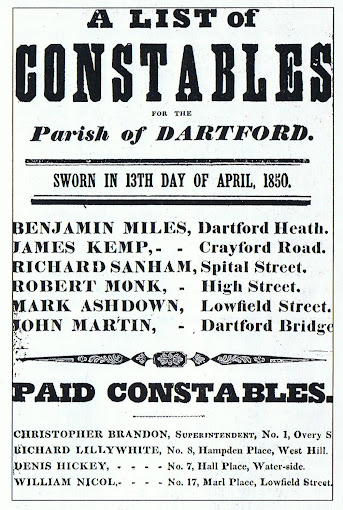Clement Thomas Youens was an elder brother of Ernest Christopher Youens (1856-1933), whose life is described in an item on this blog. This article about Clement contains information and photos from Christopher, a great grandson of Ernest. Christopher inherited diaries written by Ralph Youens (a brother of Clement) and other Youens family papers. He has donated most of this material to Kent Archives.
Clement was born on October 31st 1852 in Dartford, the seventh of ten children (two girls and eight boys) born to William and Caroline Youens, who married in 1837 and moved to Dartford in about 1845. Their children were Caroline (1839-1919), Ralph (1841-1910), Frank (1844-1910), Jesse (1846-1920), William (1848-1930), Albert Frederick (1850-1931), Clement Thomas (1852-1919), Agnes Maud (1855-1855), Ernest Christopher (1856-1933) and Urban Percival John (1859-1927). William Youens was a basket maker who was born in Fulham, a son of Thomas Youens, also a basket maker. His wife Caroline nee Eves, was born in Chatham.
William Youens, Clement’s father established a business as a basket maker in Dartford. This business became William Youens and Sons and later, Youens Brothers. Not all the sons were involved. In 1858, the eldest child, Caroline (aged 19), with the second and third sons, Frank (14) and Jesse (12), emigrated to Texas with their grandfather, Thomas Youens, who went to live with his daughters who were established there. The eldest son, Ralph did not go. He was slightly handicapped by deafness.
By 1859, William and his family had moved to Tower Cottage. This was a house that William built with his own hands. It was designed in an unusual style that incorporated some architectural features of a church. The road that it was in was later named Tower Road after the cottage. In 1861, the family living in Tower Cottage consisted of William Youens (47, a basket maker), his wife Caroline (44) and their children Ralph (19), William (12), Albert (10), Clement (8), Ernest (4) and Urban (1).
William Youens (Clement’s brother) married Ellen Elizabeth Bignall in 1874 and went to Texas later that year with Clement. They travelled on the Steamship “State of Minnesota” from Liverpool to New Orleans, arriving on 21 December 1874. The passenger list shows William (26, a carpenter), Ellen (18, William’s wife) and Clement (22, a carpenter) travelling intermediate class. Clement returned to England in 1879. This is the date of his illustrated diary (in Kent Archives) describing his voyage from Galveston to Liverpool. In it, he records that he prefers to travel by sail, rather than on a steamer.
Clement was a gifted artist and painted many pictures of local scenes and other places (such as in Texas). He also painted several pictures of birds and at least two portraits. As far as we know, he never had any formal artistic training but he moved in artistic circles and knew the noted English Impressionist artist Dorothea Sharp (1874-1955), who was born in Dartford. He sold some of his paintings and did artistic work on commission. Examples of Clement’s paintings (dated from 1884 to 1900) are held at Dartford museum and can be viewed at http://www.bbc.co.uk/arts/yourpaintings/artists/clement-t-youens.
The River Cray
near Crayford by Clement T Youens.
The painting above is 14 by 10 inches, painted in oil on artists’ card. Many of Clement’s paintings are 14 x 10, but some are considerably larger and some are miniatures. He used watercolour as well as oil, painted on canvas and wood as well as artists’ card and branched into other decorative arts such as painting over photographs and decorating mirrors.
In 1891, Caroline Youens (73) was living at Tower Cottage, 15 Tower Road with her unmarried sons Ralph (49), Albert (40), Clement (38), and Urban (31). Ralph and Clement were basket makers. Albert and Urban were both described as “artist in natural flowers”. Clement made another journey to Texas, returning in June 1894. Caroline Youens died in August 1894 aged 76.
Standing from left: Clement, Ernest, Albert, Urban Youens. Seated from left:
Ralph, Caroline, Harold, Marion, Kate Youens (Ernest’s children and wife) c 1894.
The 1901 census shows Clement (aged 48, a basket and picture frame maker) and his brother Ralph (aged 60, a basket maker) living at 15 Tower Road, Dartford. Later that year Clement married Kathleen Annie Redsell. He was aged 49, she was aged 29, a daughter of John and Emma Redsell of Stoneham Farm near Dartford. Clement met Kathleen when painting a picture of the farm. After their marriage they lived at “Rockleigh”, 30 Tower Road and had daughters Marjorie Kathleen in 1904 and Olive Brenda in 1906.
Throughout her life, Caroline maintained harmony between
her sons. She was a good woman of strong character and will. But, after her
passing, harmony broke down. Albert and Urban retired from service, returned to
live in Tower Cottage and established their floral art business. A coolness
developed between them and Ralph which turned into open hostility. They appear
to have occupied most of the house, restricting Ralph to his bedroom and
workshop. Albert and Ralph were very different people. Ralph was quiet, shy,
humble and rather bumbling. Albert was quick witted, quick tempered,
aristocratic and, as a butler, used to being obeyed. He did not suffer fools
gladly and probably regarded Ralph as such. Urban was devoted to Albert and
followed wherever he led. There could, too, have been competition for space as
the growing and successful floral art business encroached on the areas reserved
for basket making. Clement became Ralph’s mainstay. Although Ralph slept and
worked in Tower Cottage, he really lived in Rockleigh, going there for meals, friendship
and comfort.
In the first decade of the twentieth century, whilst the floral art business and Ernest’s photography business were becoming increasingly successful, the basket-making business was declining. Ralph was often idle for want of orders. Income became less and left both him and Clement in financial difficulties. Clement and Kathleen eased their problems by taking in a lodger. Jesse, economically the most successful of the brothers, appears to have subsidised them by sending large financial gifts at Christmas. Perhaps Clement devoted a little too much time to artistic pursuits and not enough to understanding basic business skills! As well as loving the visual arts, he was a keen singer who belonged to Chapel and secular choirs.
Clement shared the Liberal political views of his brothers. There are records of his wife working on the Ladies’ committee to support the Liberal candidate at election times. Clement was a regular worshipper at the Congregational Church and participated in many of its events and activities.
Ralph died in 1910. The 1911 census shows Clement (59, a basket and picture frame maker), Kathleen (38), Marjorie (7) and Olive (4), plus a lodger living at 30 Tower Road, Dartford.
Clement with his
wife and daughters c 1910
Clement died on May 24th 1919 aged 66. He is buried in East Hill Cemetery. Burial records say that he died at 30 Tower Road (his home address) and give his occupation as picture frame maker and artist. The burial service was conducted by a minister of the Congregational Church.
His gravestone is inscribed:
In / loving memory / of / WILLIAM YOUENS / died June 14, 1870 / Also of RALPH YOUENS / eldest son of above / born May 7, 1841 died Nov 30 1910 / “A life that all the muses decked / with gifts of grace that might express / all comprehensive tenderness / all subtilising intellect.” / Also CLEMENT THOMAS YOUENS / born Oct 31st 1852, died May 24th 1919 / Also KATHLEEN ANNIE / wife of the above / CLEMENT THOMAS YOUENS / born May 13th 1872, died Nov 23rd 1933.
Clement’s
gravestone in East Hill Cemetery, Dartford.
The quotation is from Tennyson’s poem In Memoriam. The adjacent grave is that of Clement’s mother (Caroline) and his brothers Albert and Urban. Nearby is the grave of his brother Ernest. Cemetery records show that William Youens (Clement’s father) is actually buried in another grave (which is unmarked) in the cemetery.
Probate records show that Clement left an estate valued at £352 (equivalent to about £60,000 now). Kathleen (his widow) was the executor of his will.
The 1921 census shows Kathleen Annie Youens, aged 49, still living at 30 Tower Road, Dartford, with her daughters Marjorie (17) and Olive (15) as well as her mother Emma Redsell (74).
Kathleen died on 23 November 1933 aged 61 in Dartford. She was cremated in Lambeth.
Clement’s daughters later moved to a house that Marjorie
designed at 29 Devonshire Avenue, Dartford. Marjorie died in 1956 aged 52,
Olive in 1993 aged 87. Neither married or had children.










